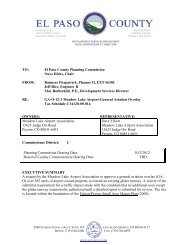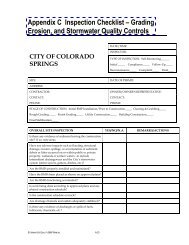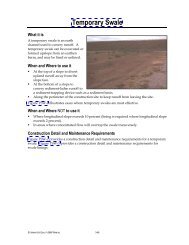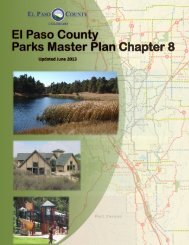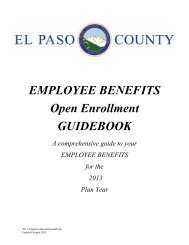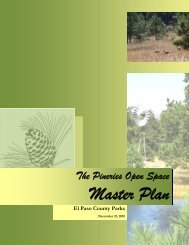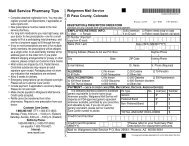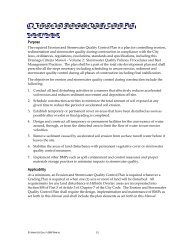Playing by the Rules: A Handbook for CDBG ... - City of El Cajon
Playing by the Rules: A Handbook for CDBG ... - City of El Cajon
Playing by the Rules: A Handbook for CDBG ... - City of El Cajon
You also want an ePaper? Increase the reach of your titles
YUMPU automatically turns print PDFs into web optimized ePapers that Google loves.
<strong>Playing</strong> <strong>by</strong> <strong>the</strong> <strong>Rules</strong><br />
A <strong>Handbook</strong> <strong>for</strong> <strong>CDBG</strong> Subrecipients on Administrative Systems<br />
• If <strong>CDBG</strong> grant advances are placed in an interest-bearing account <strong>by</strong> a subrecipient,<br />
<strong>the</strong> subrecipient must return this interest income to <strong>the</strong> U.S. Treasury via <strong>the</strong> grantee<br />
(per 24 CFR 85.21(i) or 570.502(b)(3)(i), as applicable, and 24 CFR 570.500(a)(2)).<br />
Such interest income is not considered program income. Similarly, if a subrecipient<br />
uses a “revolving loan fund account” under <strong>the</strong> <strong>CDBG</strong> program, <strong>the</strong> funds must be<br />
deposited in an interest bearing account, and all interest earned on funds on<br />
deposit must be returned to <strong>the</strong> Treasury via <strong>the</strong> grantee no less frequently than<br />
annually (24 CFR 570.500(b)).<br />
• Program income (o<strong>the</strong>r than program income deposited in a revolving fund) must<br />
be disbursed in payment <strong>of</strong> program costs be<strong>for</strong>e requesting fur<strong>the</strong>r drawdowns<br />
from <strong>the</strong> grantee (24 CFR 570.504(b)(2)(ii) and 570.504(c)).<br />
• If program income is put in an approved revolving fund <strong>by</strong> a subrecipient, <strong>the</strong><br />
subrecipient must disburse this program income <strong>for</strong> <strong>the</strong> same activity <strong>for</strong> which <strong>the</strong><br />
revolving fund was established, be<strong>for</strong>e making fur<strong>the</strong>r cash drawdown requests to <strong>the</strong><br />
grantee <strong>for</strong> <strong>the</strong> activity. The account must be interest bearing, and interest earned or<br />
funds held in <strong>the</strong> account must be remitted to <strong>the</strong> grantee at least annually (24 CFR<br />
570.504(b)(2)(i) and 570.500 (b)).<br />
• Funds held in an escrow account <strong>for</strong> rehabilitation activities generally must be<br />
disbursed within 10 days (24 CFR 570.511(a)(4)).<br />
While avoiding excessive drawdowns, a subrecipient should also exercise care that <strong>the</strong> legitimate<br />
cash needs <strong>of</strong> its <strong>CDBG</strong> activities are being met. As noted in <strong>the</strong> preceding section, a<br />
subrecipient needs to be able to <strong>for</strong>ecast accurately what its project expenses are going to be. If<br />
its <strong>CDBG</strong> activities are relatively stable (<strong>the</strong> same type and level <strong>of</strong> activities from month to<br />
month), a subrecipient can begin with <strong>the</strong> previous month’s financial activity as a starting point<br />
<strong>for</strong> its estimate <strong>of</strong> current period cash needs. This estimate, however, should be modified <strong>for</strong><br />
periodic expenses or seasonal variations in costs, such as <strong>for</strong> heating and electricity. If a<br />
subrecipient’s activities are expanding or exhibit irregular fluctuations in expenses, <strong>the</strong>n it is<br />
important to devote more careful attention to predicting future cash requirements.<br />
It should be noted that, in <strong>the</strong> private sector, <strong>the</strong> “cash requirements report” is a standard<br />
management tool <strong>for</strong> anticipating <strong>the</strong> monthly (or even weekly) cash flow needs <strong>of</strong> a business.<br />
When a subrecipient is not able to plan its expenditures and encounters large fluctuations in <strong>the</strong><br />
disbursement <strong>of</strong> obligated funds (as can happen, <strong>for</strong> example, in construction activities), <strong>the</strong>re is<br />
a tendency to invade o<strong>the</strong>r non-<strong>CDBG</strong> funds, or alternatively to “temporarily borrow” <strong>CDBG</strong><br />
funds <strong>for</strong> non-<strong>CDBG</strong> purposes. Such inter-fund transfers that result in using <strong>CDBG</strong> funds <strong>for</strong><br />
Chapter 2–15



